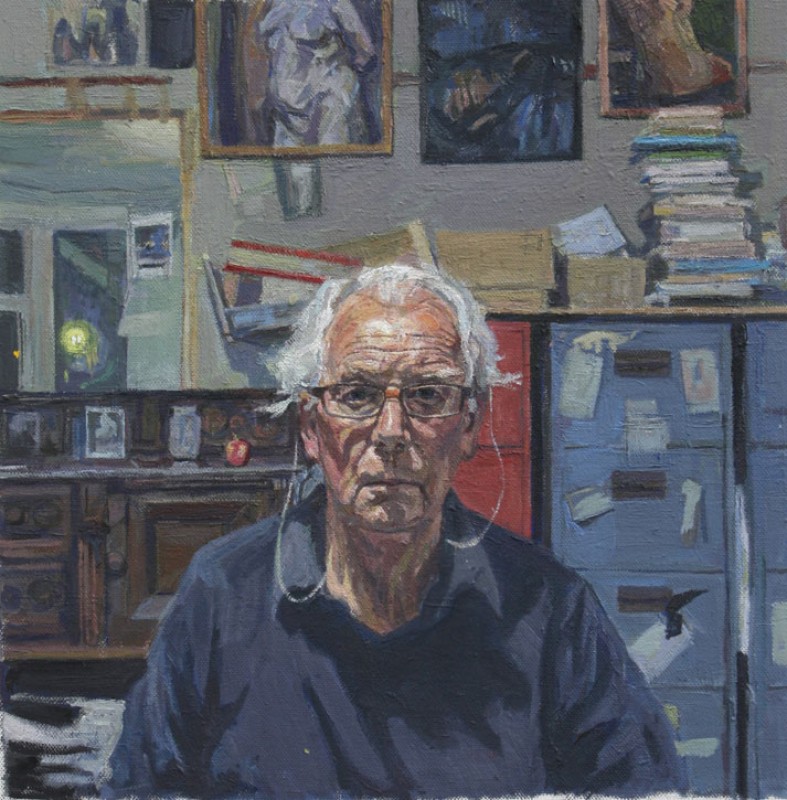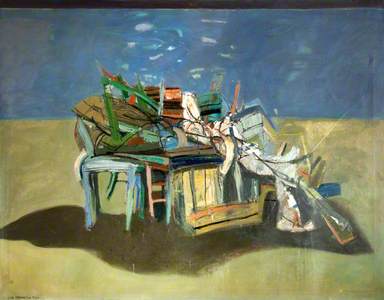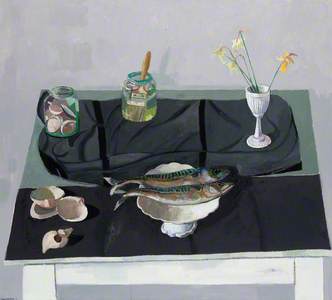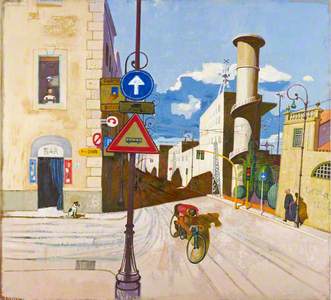Leon Morrocco RSA – an artist widely regarded as one of the greatest Scottish painters of his generation – is being celebrated in his 80th year with a solo exhibition at the Royal Scottish Academy of Art and Architecture, highlighting some of the lesser-known aspects of his long career.
The eldest son of the painter and teacher Alberto Morrocco RSA (1917–1998), Leon Morrocco was born in Edinburgh in 1942, and is an elected Member of the RSA. He is surpassed in length of tenure only by the Inverness-born painter Peter Collins and the painter and printmaker Frances Walker.
The Studio with Lay Figure
1993
Alberto Morrocco (1917–1998) 
Morrocco was first elected as an RSA Associate (ARSA) in 1971, exactly 20 years after his father had enjoyed the same honour – Alberto was aged 34, and Leon just 29.
In 2002, four years after his father's death, Leon Morrocco was elevated to full Academician rank. Of all of those elected Associates in 1971, only Morrocco and the architect Robert Steedman are still alive.
Morrocco is one of only 14 artists who have followed one of their parents onto the Membership roll of the RSA. Robbie Bushe RSA, who until 2021 was the RSA Secretary, is the only other living Member who is also the child of a past Academician.
Two's Company, Three's Bloody Chaotic
1990
Robbie Bushe (b.1964) 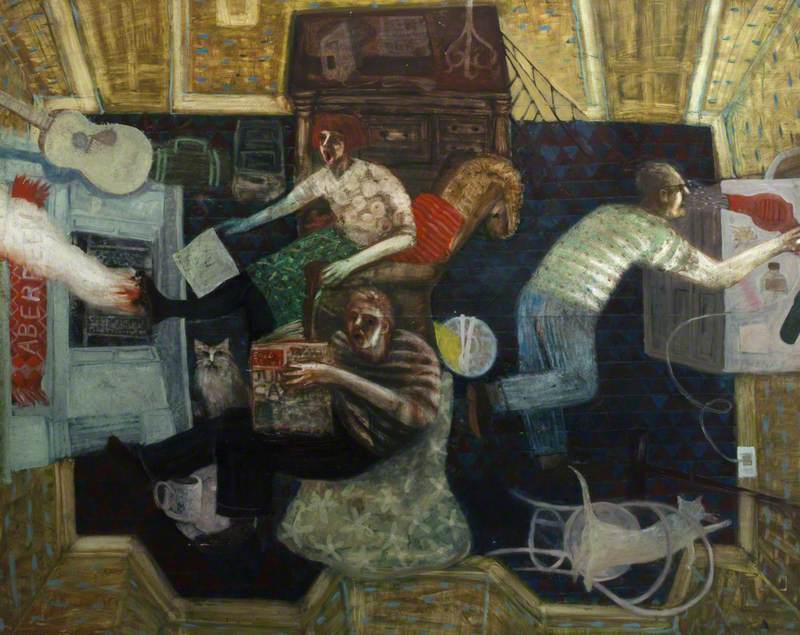
Robbie Bushe's election came after the death of his father, the sculptor Fred Bushe (1931–2009), who, among other achievements, set up the Scottish Sculpture Workshop in Aberdeenshire in the 1970s.
Morrocco undertook his training at Duncan of Jordanstone College of Art in Dundee, the Slade School of Fine Art in London, and Edinburgh College of Art (ECA).
It was at the end of three years on the teaching staff at ECA that Morrocco was awarded an Italian government scholarship, which took him to the Accademia di Brera in Milan in 1969.
On his return to Scotland the same year, he took up a similar teaching post, this time at Glasgow School of Art, where he stayed for a full ten years before emigrating to Australia to become Head of the Department of Fine Art at Melbourne's Chisholm Institute.
After four years at the Chisholm, Morrocco gave up teaching in 1983 to concentrate on painting full time. Following a number of successful exhibitions, he returned to the UK in 1992, settling in London, which remains his base 30 years on.
To follow a parent is challenging at the best of times, but to do so successfully in the same field is perhaps a challenge of even greater magnitude.
There are elements of Morrocco's work that bear more than a nod in the direction of the work of his father, but there is little risk of their work being mistaken, such is the stamp that Morrocco junior has placed on his own practice.
Perhaps it is a manifestation of his surname (allowing for the spelling difference), with its evocation of sunny climes and joyous colours, that makes a Leon Morrocco painting so immediately recognisable.
He is a consummate draughtsman, as evidenced by his early Basket Chair and Lamp, and he has been prolific in his output, constantly striving to produce, in his own words, the best that he possibly can.
If at times his work presents a sense of déjà vu, that can be put down to his doing exactly that – striving to produce the best that he possibly can. A subject tackled more than once is a reflection that he didn't quite 'get it right' at the first attempt.
His work is kaleidoscopic. Kaleidoscopic not only in terms of the richly juxtaposed and at times textured arrangement of the paint on the canvas, but kaleidoscopic too in terms of the fragmented references to twentieth-century Scottish art, which – consciously or not – it contains.
Two Mackerel does not seek to impersonate but nonetheless pays homage to the masterful late still-life paintings of William Gillies, for example, whilst works like White Town in Green suggest the Corsican and Spanish townscapes of Anne Redpath's late years.
Boats and Boats and Houses speak of Ian Fleming and William Burns, whilst the interest of placing still lifes in windows with a wider landscape beyond, or of placing the still life within the landscape itself, are reminiscent of the work of William Littlejohn and ultimately of the significant influence of James Cowie.
Studio Window has a bit of David McClure or Robert Henderson Blyth to it.
Fish Market has similarities with the paintings of Morrocco's friend and colleague David Michie.
But whatever the influences, real or perceived, at heart Morrocco is a colourist, and a rather good one at that. This has evolved through his career even if early works such as Profile of Woman or Italian Landscape do not yet show that.
Figure in Landscape suggests a promise of the feast to come.
His celebration of the joie de vivre is in the same vein as the work of J. D. Fergusson, but in his ability to capture sunlight, as in his RSA Diploma Collection deposit The Cyclist, Via Giolitti, he lies much closer to S. J. Peploe.
The Cyclist, Via Giolitti
2002
Leon Francesco Morrocco (b.1942) 
Morrocco works from sketches, often highly detailed, and invariably in his own words containing much more information than he will ever need. In his paintings of places, he seeks not to recreate photographic renditions but rather to evoke the sense of place.
Study for ‘House Contents’
1965
Leon Francesco Morrocco (b.1942) 
His most recent major collection is of truly monumental works inspired by the Alpes-Maritimes in France. Talking of these works, Morrocco has spoken of his excitement in the studio. Having done his preparatory sketches and transferred these to the canvas, and prepared his palette, he picks up his brushes to apply the first colour. A peace-loving individual, nonetheless he perceives a sense of battle; 'taking the fight' to the canvas.
He is also aware that he is looking to find new solutions to the challenges his subject matter poses, and, hearteningly for a man so mature in his years, he is constantly learning, even now. These all go together to produce a series of landscapes which must rank among the finest landscapes ever painted by a Scottish artist.
Robin Rodger, Documentation Officer at the RSA
'Leon Morrocco: Long Road Home' is at the Royal Scottish Academy of Art and Architecture until 28th August 2022















